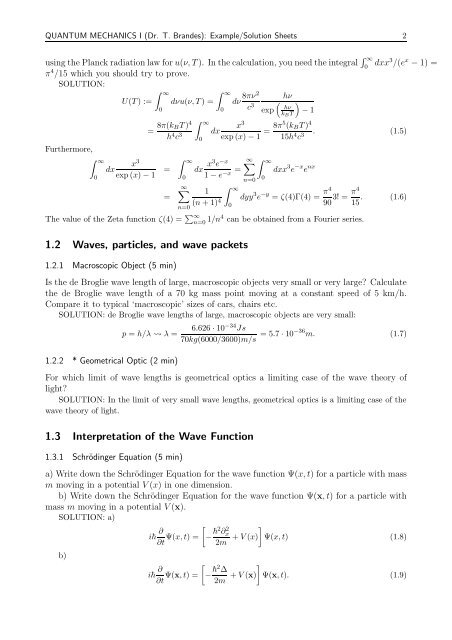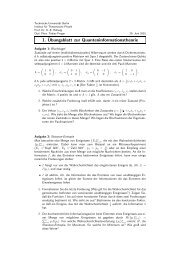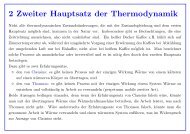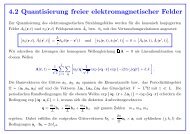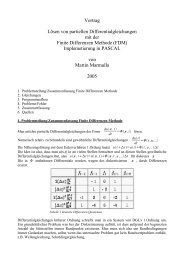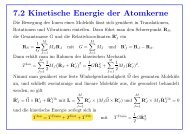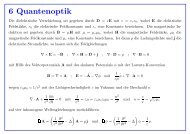1.1 The Radiation Laws and the Birth of Quantum Mechanics
1.1 The Radiation Laws and the Birth of Quantum Mechanics
1.1 The Radiation Laws and the Birth of Quantum Mechanics
Create successful ePaper yourself
Turn your PDF publications into a flip-book with our unique Google optimized e-Paper software.
QUANTUM MECHANICS I (Dr. T. Br<strong>and</strong>es): Example/Solution Sheets 2<br />
using <strong>the</strong> Planck radiation law for u(ν, T ). In <strong>the</strong> calculation, you need <strong>the</strong> integral ∫ ∞<br />
dxx 3 /(e x − 1) =<br />
0<br />
π 4 /15 which you should try to prove.<br />
SOLUTION:<br />
Fur<strong>the</strong>rmore,<br />
∫ ∞<br />
0<br />
U(T ) :=<br />
x 3<br />
dx<br />
exp (x) − 1<br />
∫ ∞<br />
0<br />
= 8π(k BT ) 4<br />
h 4 c 3<br />
=<br />
=<br />
dνu(ν, T ) =<br />
∫ ∞<br />
0<br />
∫ ∞<br />
0<br />
∫ ∞<br />
0<br />
dν 8πν2<br />
c 3<br />
x 3<br />
hν<br />
exp<br />
(<br />
hν<br />
k B T<br />
)<br />
− 1<br />
dx<br />
exp (x) − 1 = 8π5 (k B T ) 4<br />
15h 4 c 3 . (1.5)<br />
dx x3 e −x<br />
1 − e −x = ∞ ∑<br />
∞∑<br />
∫<br />
1 ∞<br />
(n + 1) 4<br />
n=0<br />
0<br />
n=0<br />
∫ ∞<br />
0<br />
dxx 3 e −x e nx<br />
dyy 3 e −y = ζ(4)Γ(4) = π4 π4<br />
3! =<br />
90 15 . (1.6)<br />
<strong>The</strong> value <strong>of</strong> <strong>the</strong> Zeta function ζ(4) = ∑ ∞<br />
n=0 1/n4 can be obtained from a Fourier series.<br />
1.2 Waves, particles, <strong>and</strong> wave packets<br />
1.2.1 Macroscopic Object (5 min)<br />
Is <strong>the</strong> de Broglie wave length <strong>of</strong> large, macroscopic objects very small or very large Calculate<br />
<strong>the</strong> de Broglie wave length <strong>of</strong> a 70 kg mass point moving at a constant speed <strong>of</strong> 5 km/h.<br />
Compare it to typical ‘macroscopic’ sizes <strong>of</strong> cars, chairs etc.<br />
SOLUTION: de Broglie wave lengths <strong>of</strong> large, macroscopic objects are very small:<br />
p = h/λ λ =<br />
1.2.2 * Geometrical Optic (2 min)<br />
6.626 · 10 −34 Js<br />
70kg(6000/3600)m/s = 5.7 · 10−36 m. (1.7)<br />
For which limit <strong>of</strong> wave lengths is geometrical optics a limiting case <strong>of</strong> <strong>the</strong> wave <strong>the</strong>ory <strong>of</strong><br />
light<br />
SOLUTION: In <strong>the</strong> limit <strong>of</strong> very small wave lengths, geometrical optics is a limiting case <strong>of</strong> <strong>the</strong><br />
wave <strong>the</strong>ory <strong>of</strong> light.<br />
1.3 Interpretation <strong>of</strong> <strong>the</strong> Wave Function<br />
1.3.1 Schrödinger Equation (5 min)<br />
a) Write down <strong>the</strong> Schrödinger Equation for <strong>the</strong> wave function Ψ(x, t) for a particle with mass<br />
m moving in a potential V (x) in one dimension.<br />
b) Write down <strong>the</strong> Schrödinger Equation for <strong>the</strong> wave function Ψ(x, t) for a particle with<br />
mass m moving in a potential V (x).<br />
SOLUTION: a)<br />
i ∂ [<br />
∂t Ψ(x, t) = − 2 ∂x<br />
2 ]<br />
2m + V (x) Ψ(x, t) (1.8)<br />
b)<br />
i ∂ ∂t Ψ(x, t) = [<br />
− 2 ∆<br />
2m + V (x) ]<br />
Ψ(x, t). (1.9)


